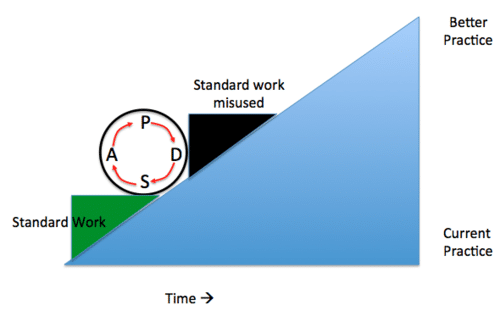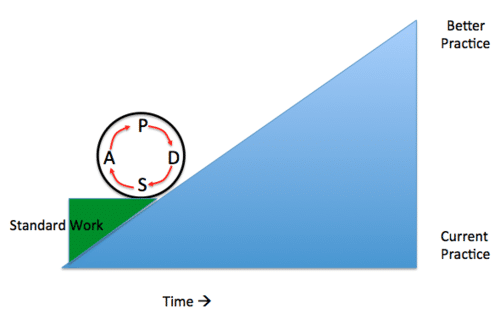By John Hunter, founder of CuriousCat.com.
When people first learn of standard work within the Deming context (or lean manufacturing or the other flavors of management with some process focus) they often fear it means following outdated processes that are ineffective. I believe this is because, if they have experience with standards, that experience was a bad experience. They likely suffered from the equivalent of processes written in stone that no longer make sense but no one knew how, or no one had the authority to officially change them.
Often this results in people unofficially “changing them” (leaving them as they are, but) using their own variations. This often results in chaos (though often delayed until those knowing the right undocumented processes to follow are not around), including making process improvement difficult as the baseline state is so confusing.
One sign of progress in management systems over the last 20 years is there are many more organizations providing good experiences with standardized work processes (often from Deming based or lean manufacturing based management systems).
For standard work processes to be effective the organization needs to create a culture of process thinking (without that people don’t respect the importance of standard work and chaos and poor results ensue). Process thinking is a natural result of the Deming’s management ideas: evidence based management, PDSA, understanding variation, eliminating non-value added work, encouraging joy in work (which requires letting people view how they contribute to providing customer value), etc..
In my experience, you need to make sure standard work isn’t seen as rules written in stone (next to impossible to change). This is actually less of a risk than it may seem. If it is a problem, it normally stems from one of these two issues in a management systems:
- Strong command and control style without any of the requirements for Deming’s management ideas (lack of respect for people, lack of understanding of gemba, limited process thinking – if any, limited customer focus…).
- Early transitions to Deming (or lean manufacturing or some process thinking management system) based organization, where tools and concepts are applied a bit crudely. In adopting standards they react against the tradition of chaos by writing rules in stone. This quickly goes away (because the rest of the Deming management system effort pushes in the right direction so such a misapplication of standarization can’t last) unless the effort is merely using a couple tools without changing the management thinking. In the latter case there is no Deming management system. Without a management system that has many tools, practices and concepts working in concert to create a successful system then misapplication of tools and concepts is likely rampant in many ways: including the possibility of standard work being done in a completely wrong way – as though the standards are written in stone.
Mike Stoecklein has a great graphic illustration how standard work instructions should aid process performance
and how misapplying standard work creates problems for some organizations (from his post: Standard Work and PDSA [broken link removed]).

Standard work should lock in process improvements and avoid the common practice of performance degrading in organizations without process thinking cultures. Degrading performance over time is common when an improvement project is completed, if the improved process isn’t documented clearly and the new standard process is not adopted by everyone. But standard work should not prevent the vital continual improvement of processes.
Standards need to be followed until a decision is made to run an experiment (PDSA) to learn and improve the process. If there is a problem with the following the standards that must be brought up and addressed. In a Deming based management system, it is not acceptable to have standard work processes that don’t work and require workers to take various countermeasures in order to deliver what is required.
A “decision is made to run an experiment” sounds like writing the process in stone, in many organizations. If that is the case for your organization, that is an indication the organization needs to do a great deal more work on creating a continual process improvement culture.
The Act phase of the PDSA cycle includes, standardization of the process and deployment of that standard work process across the organization.
Related: Reflections on Standard Work [broken link removed] – Why Standard Work is not Standard: Training Within Industry Provides an Answer – Building up Standard Work Using Job Instruction – Why Isn’t Work Standard? – Arbitrary Rules Don’t Work



